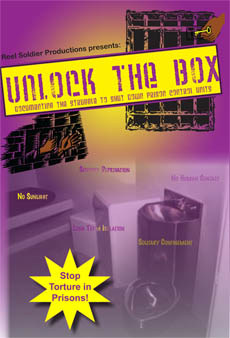The recent mass hunger strike got the prisoncrats’ attention even though
the prisoncrats seek to downplay or minimize the success of the strike
by spoon feeding the media. In particular, their Sacramento Bee spin
doctor stooge accepts the official representations which contain very
few facts mixed with the typical misleading, provocative and confusing
innuendo so as to perpetuate their coined myths.
The public is gullible and must be constantly educated to see through
muddy water. Such has been the case for years because of the assumption
that government officials and law enforcement allegedly have their
safety, security and best interests at the forefront when it’s really
all about the money or budget. The CDCR purveys to the public that the
most dangerous and supposedly most hardened prison gang leaders called
for the hunger strike even though they also claim that the modus
operandi of gangs are violence and intimidation which is totally
contrary to the utilization of a passive non-violent form of protest
which requires self restraint and determination.
The secretary, Matthew Cate, stated in a CDCR prepared statement that
“hunger strikes are dangerous and ineffective as a means for prisoners
to attempt to negotiate.” Yet, the administrative appeal process is also
dangerous and ineffective as each level rubber stamps the arbitrary
decision of the prior level. Even when the decision was obviously in
error and a threat to prisoner health and safety, they refuse to accept
responsibility and accountability.
What the secretary has not said is that the hunger strike by masses of
prisoners have in fact overwhelmed the prison medical department with
additional medical expense to an already overburdened prison healthcare
system. The strikers pose a more significant problem for the
prisoncrats’ budget than the shooting and gassing of violent prisoners
in prison uprisings or even non-violent prisoners who are also shot,
gassed/sprayed and beat with zeal as prisoncrats claim they were a
threat to institutional security [see
grievance
campaign].
Prisoncrats, as any conscious prisoner should know, could not care less
about the health of prisoners. They do care about the expense of
providing constitutional mandated medical care. Therefore we should
question the prisoncrats’ claim to have had plans since January to
review and change some policies, which were only revealed to us after
weeks of food strikes.
Prisoncrats tend to take full advantage of the divide and conquer
concept and are at their best when they are able to pit the lumpen
divisions against each other for amusement or distraction which is why
one should be suspicious of any claim by the prisoncrats to want to
eliminate what they have for years encouraged and perpetuated in the
penal system to justify the excessive prison budget.
The mass hunger strike may have only lasted 20 days, but it was like a
shot across the bow of the CDCR’s battleship by an enemy they can not
justifiably target with all their massive violent resources and
infrastructure. Yes the mass hunger strike got the prisoncrats’
attention and their immediate response was to again expand the
censorship of information prisoners receive so as to keep us unaware of
what’s going on. However, it also got their budgetary attention via
their healthcare pocketbook.
The hunger strike also got the attention of the CCPOA which realizes
that such strikes benefit the SEIU who are gaining more clout in the
prison system and custody staff have effectively been rendered impotent
as they do not have a real or effective contingency for dealing with
non-violent forms of protest that they can not counteract or employ
violence to suppress and to that extent the mass hunger strike was a
success.
MIM(Prisons) responds:
Many are writing in disappointed with
the outcome of the California hunger strike so far. But as this comrade
points out, the strategy of the hunger strikers was effective in a
number of ways. And as the CDCR is given a “brief grace period,” as one
of the strike initiators called it, we are regrouping. There are many
who just found out about the strike as it was happening. If the CDCR
continues to drag its feet on making any real changes, as we all expect
they will, we should see an even stronger and more widespread response
from prisoners across California and beyond. Of course, CDCR is
regrouping as well, and we must guard against efforts to trick prisoners
into thinking they do not share the same conditions and the same
enemies.






 Alabama
Alabama
 Alaska
Alaska
 Arizona
Arizona
 Arkansas
Arkansas
 Army Post
Army Post
 California
California
 Colorado
Colorado
 Connecticut
Connecticut
 Delaware
Delaware
 District of Columbia
District of Columbia
 Federal
Federal
 Florida
Florida
 Georgia
Georgia
 Guam
Guam
 Hawaii
Hawaii
 Idaho
Idaho
 Illinois
Illinois
 Indiana
Indiana
 Iowa
Iowa
 Kansas
Kansas
 Kentucky
Kentucky
 Louisiana
Louisiana
 Maine
Maine
 Maryland
Maryland
 Massachusetts
Massachusetts
 Michigan
Michigan
 Minnesota
Minnesota
 Mississippi
Mississippi
 Missouri
Missouri
 Montana
Montana
 Nebraska
Nebraska
 Nevada
Nevada
 New Hampshire
New Hampshire
 New Jersey
New Jersey
 New Mexico
New Mexico
 New York
New York
 North Carolina
North Carolina
 North Dakota
North Dakota
 Ohio
Ohio
 Oklahoma
Oklahoma
 Oregon
Oregon
 Pennsylvania
Pennsylvania
 Puerto Rico
Puerto Rico
 Rhode Island
Rhode Island
 South Carolina
South Carolina
 South Dakota
South Dakota
 Tennessee
Tennessee
 Texas
Texas
 Utah
Utah
 Vermont
Vermont
 Virginia
Virginia
 Washington
Washington
 West Virginia
West Virginia
 Wisconsin
Wisconsin
 Wyoming
Wyoming
